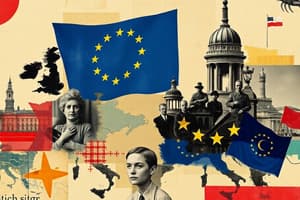Podcast
Questions and Answers
What was the focus of the Convention on the future of the EU?
What was the focus of the Convention on the future of the EU?
- Increased bureaucracy and complexity
- Better division of competences (correct)
- Expansion of the European Council
- Dissolution of the EU
Who comprised the Convention on the future of the EU?
Who comprised the Convention on the future of the EU?
- Representatives from non-EU countries
- European Council members only
- Only representatives from Member States governments
- Chair, two vice-chairs, representatives of MS governments, EP, national parliaments, and Commission (correct)
When was the Treaty of Lisbon signed?
When was the Treaty of Lisbon signed?
- 18 June 2004
- 29 October 2004
- 13 December 2007 (correct)
- 1 December 2009
What replaced the EC-EU dualism and pillars according to the Treaty of Lisbon?
What replaced the EC-EU dualism and pillars according to the Treaty of Lisbon?
How many institutions were added under the Treaty of Lisbon?
How many institutions were added under the Treaty of Lisbon?
What system of voting in Council was introduced by the Treaty of Lisbon?
What system of voting in Council was introduced by the Treaty of Lisbon?
What is the legal value of the Charter of Fundamental Rights according to the Treaty of Lisbon?
What is the legal value of the Charter of Fundamental Rights according to the Treaty of Lisbon?
What was introduced by the Treaty of Lisbon to strengthen participation of national parliaments and citizens?
What was introduced by the Treaty of Lisbon to strengthen participation of national parliaments and citizens?
What clause was introduced by the Treaty of Lisbon for withdrawal from the EU?
What clause was introduced by the Treaty of Lisbon for withdrawal from the EU?
What is the significance of the 1986 Single European Act?
What is the significance of the 1986 Single European Act?
What event preceded the 1986 Single European Act?
What event preceded the 1986 Single European Act?
What did the Single European Act recognize?
What did the Single European Act recognize?
What was the deadline set by the Single European Act?
What was the deadline set by the Single European Act?
Which treaty focused on the free movement of goods, persons, services, and capital?
Which treaty focused on the free movement of goods, persons, services, and capital?
What did the Single European Act introduce?
What did the Single European Act introduce?
Which treaty emphasized the importance of European integration?
Which treaty emphasized the importance of European integration?
Which treaty renamed the European Community and expanded EC powers?
Which treaty renamed the European Community and expanded EC powers?
Which treaty established the Common Foreign and Security Policy and codified European Political Cooperation?
Which treaty established the Common Foreign and Security Policy and codified European Political Cooperation?
Which treaty introduced enhanced cooperation, simplification, and greater transparency?
Which treaty introduced enhanced cooperation, simplification, and greater transparency?
Which treaty aimed to make EU institutions more efficient and legitimate and prepare the EU for major enlargement?
Which treaty aimed to make EU institutions more efficient and legitimate and prepare the EU for major enlargement?
Which treaty introduced the 'nuclear procedure' for addressing serious and persistent breaches of principles by a Member State?
Which treaty introduced the 'nuclear procedure' for addressing serious and persistent breaches of principles by a Member State?
Which treaty granted competence to undertake Petersberg tasks to the EU?
Which treaty granted competence to undertake Petersberg tasks to the EU?
Which treaty included detailed provisions on Economic and Monetary Union and the time-path for the European Currency Unit (ECU)?
Which treaty included detailed provisions on Economic and Monetary Union and the time-path for the European Currency Unit (ECU)?
Which treaty fixed the maximum number of MEPs at 700 and scrapped obsolete treaty provisions?
Which treaty fixed the maximum number of MEPs at 700 and scrapped obsolete treaty provisions?
Study Notes
- The 1986 Single European Act (II) introduced stronger roles for the European Parliament, created the Court of First Instance (now General Court), established the Political Committee and Secretariat for European Political Cooperation, and introduced new Community policies in areas such as health and safety, economic and social cohesion, research and technological development, environment, and cooperation in economic and monetary policy.
- The 1992 Maastricht Treaty (I) was preceded by the Delors Report on Economic and Monetary Union and the end of communist regimes in Europe, leading to two intergovernmental conferences in December 1990. The result was the Treaty on European Union, signed on 7 February 1992 and entering into force on 1 November 1993. Ratification was hindered by referendums in Denmark and France, as well as challenges in Germany's Constitutional Court.
- The Maastricht Treaty (II) created a European Union based on three pillars: three Communities, Common Foreign and Security Policy (CFSP), and cooperation in the fields of justice and home affairs (JHA). The EU did not gain international legal personality, and the European Council was recognized as an organ. The subsidiarity principle was recognized, and the first reference to fundamental rights was made in Article F(2) TEU.
- The Maastricht Treaty (III) renamed the European Community, expanded EC powers, introduced Union citizenship, and included detailed provisions on Economic and Monetary Union and the time-path for the European Currency Unit (ECU). The Treaty also introduced a stronger role for the European Parliament, created the Committee of the Regions, and foreshadowed a revision conference in 1996.
- The 1992 Maastricht Treaty (IV) established the Common Foreign and Security Policy, codifying European Political Cooperation. The Council held a central role, with the Commission "fully associated," but with little power. The European Parliament had no exclusive right of proposal, and unanimous decision-making was required. The Member State holding the rotating presidency represented the EU internationally.
- The 1992 Maastricht Treaty (V) established pillar 3 for cooperation in justice and home affairs, focused on topics where sovereignty runs deep. The intergovernmental method was used, with unanimous decision-making and the Council having a central role. The Commission was "fully associated," but with no exclusive right of proposal. The instruments were not well-elaborated, and a "passerelle" bridge to the first pillar was included.
- The 1997 Amsterdam Treaty (I) introduced sustainable development into the Treaties, emphasizing the principles of liberty, democracy, respect for human rights and fundamental freedoms, and the rule of law. The "nuclear procedure" was introduced for addressing serious and persistent breaches of those principles by a Member State. Social accents were added, some Third Pillar provisions were "communitarized," and the Schengen Agreement and acquis were included.
- The Amsterdam Treaty (II) introduced enhanced cooperation, simplification, and greater transparency. The number of Commissioners was increased to one per Member State, and more cases of codecision were included. The European Parliament gained power to approve the nomination of the President of the Commission and the maximum number of MEPs was fixed at 700. Obsolete Treaty provisions were scrapped, and CFSP was significantly amended.
- The 2001 Nice Treaty (I) aimed to make EU institutions more efficient and legitimate and prepare the EU for major enlargement. Adaptations were made to the system of calculation for qualified majority voting, the maximum number of MEPs was fixed at 732, and the EU was granted competence to undertake Petersberg tasks itself. Enhanced cooperation was possible for CFSP, but excluding matters with military or defense implications.
- The Nice Treaty (II) reformed the European Council, Political and Security Committee, and European Court of Justice. The High Representative for CFSP was created, and a treaty-making procedure for CFSP was established. Constructive abstention was possible, and some JHA provisions were partially communitarized. Clearer instruments, including "Framework Decision," were introduced.
Studying That Suits You
Use AI to generate personalized quizzes and flashcards to suit your learning preferences.
Related Documents
Description
Test your knowledge of the legal-political foundations of European integration with this quiz covering key treaties such as the 1986 Single European Act, the 1992 Maastricht Treaty, the 1997 Amsterdam Treaty, the 2001 Nice Treaty, the Convention and Constitutional Treaty, and the 2007 Lisbon Treaty.




